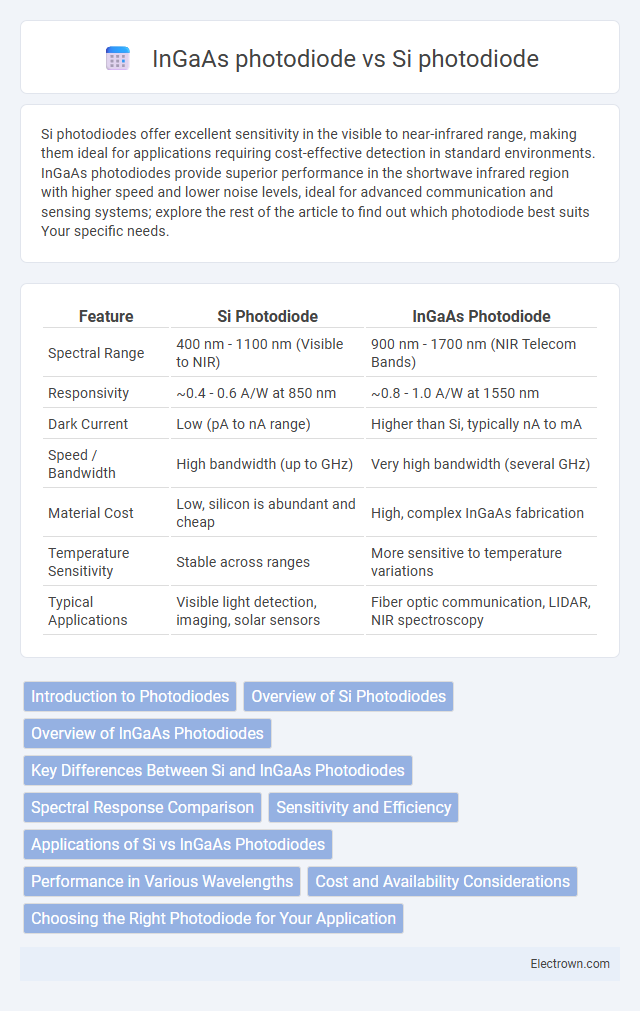Si photodiodes offer excellent sensitivity in the visible to near-infrared range, making them ideal for applications requiring cost-effective detection in standard environments. InGaAs photodiodes provide superior performance in the shortwave infrared region with higher speed and lower noise levels, ideal for advanced communication and sensing systems; explore the rest of the article to find out which photodiode best suits Your specific needs.
Table of Comparison
| Feature | Si Photodiode | InGaAs Photodiode |
|---|---|---|
| Spectral Range | 400 nm - 1100 nm (Visible to NIR) | 900 nm - 1700 nm (NIR Telecom Bands) |
| Responsivity | ~0.4 - 0.6 A/W at 850 nm | ~0.8 - 1.0 A/W at 1550 nm |
| Dark Current | Low (pA to nA range) | Higher than Si, typically nA to mA |
| Speed / Bandwidth | High bandwidth (up to GHz) | Very high bandwidth (several GHz) |
| Material Cost | Low, silicon is abundant and cheap | High, complex InGaAs fabrication |
| Temperature Sensitivity | Stable across ranges | More sensitive to temperature variations |
| Typical Applications | Visible light detection, imaging, solar sensors | Fiber optic communication, LIDAR, NIR spectroscopy |
Introduction to Photodiodes
Photodiodes convert light into electrical current using semiconductor materials, with silicon (Si) photodiodes optimized for visible to near-infrared wavelengths (400-1100 nm) due to their high sensitivity and low cost. Indium Gallium Arsenide (InGaAs) photodiodes excel in the short-wavelength infrared spectrum (900-1700 nm), offering superior responsivity and speed for telecom and spectroscopy applications. Material bandgap differences define their spectral response, making Si photodiodes ideal for general light detection and InGaAs photodiodes critical for extended near-infrared sensing.
Overview of Si Photodiodes
Si photodiodes are semiconductor devices primarily sensitive to visible and near-infrared light wavelengths, typically ranging from 400 to 1100 nm. They offer high quantum efficiency, low dark current, and fast response times, making them ideal for applications such as optical communication and environmental monitoring. Compared to InGaAs photodiodes, Si photodiodes are more cost-effective but less sensitive in the extended near-infrared region beyond 1100 nm.
Overview of InGaAs Photodiodes
InGaAs photodiodes are semiconductor devices optimized for near-infrared (NIR) detection, typically covering wavelengths from 900 nm to 1700 nm, outperforming silicon photodiodes that are limited to about 1100 nm. They offer high quantum efficiency, low dark current, and excellent sensitivity, making them ideal for applications such as optical communication, spectroscopy, and LIDAR systems. Unlike Si photodiodes, InGaAs photodiodes provide superior performance in terms of responsivity and noise characteristics in the extended infrared spectrum.
Key Differences Between Si and InGaAs Photodiodes
Si photodiodes offer high sensitivity in the visible to near-infrared range (400-1100 nm) but have limited response beyond 1100 nm. InGaAs photodiodes provide superior performance in the shortwave infrared region (900-1700 nm), featuring higher quantum efficiency and lower noise at longer wavelengths. The choice between Si and InGaAs photodiodes depends on spectral range requirements, detectivity, and application-specific sensitivity needs.
Spectral Response Comparison
Si photodiodes exhibit a spectral response primarily in the visible to near-infrared range, approximately 400 nm to 1100 nm, making them ideal for applications requiring sensitivity in this bandwidth. InGaAs photodiodes extend the spectral response into the short-wave infrared region, covering wavelengths from about 900 nm to 1700 nm, which is essential for telecom and sensing applications beyond the silicon cutoff. The choice between Si and InGaAs photodiodes depends on the specific spectral requirements, with InGaAs providing superior performance in the infrared spectrum where Si photodiodes are less effective.
Sensitivity and Efficiency
Si photodiodes exhibit high sensitivity and efficiency in the visible to near-infrared spectrum (400-1100 nm), making them ideal for applications requiring precise detection within this range. InGaAs photodiodes outperform Si types in sensitivity and quantum efficiency beyond 1100 nm, especially in the 900-1700 nm range, due to their narrower bandgap. This higher efficiency in the infrared spectrum makes InGaAs photodiodes essential for telecommunications, spectroscopy, and LIDAR systems.
Applications of Si vs InGaAs Photodiodes
Si photodiodes are widely used in visible light detection applications such as barcode scanners, optical mouse sensors, and consumer electronics due to their high sensitivity in the 400-1100 nm wavelength range. InGaAs photodiodes excel in near-infrared (NIR) and shortwave infrared (SWIR) detection from 900 to 1700 nm, making them ideal for telecommunications, fiber optic sensing, and spectroscopy. The choice between Si and InGaAs photodiodes depends primarily on the required spectral response and sensitivity for specific applications.
Performance in Various Wavelengths
Si photodiodes exhibit high sensitivity in the visible to near-infrared range, specifically between 400 nm and 1100 nm, making them ideal for applications requiring detection in these wavelengths. InGaAs photodiodes offer superior performance in the short-wave infrared spectrum, typically from 900 nm up to 1700 nm, providing enhanced quantum efficiency and lower noise levels in this range. The choice between Si and InGaAs photodiodes depends largely on the required spectral response, with Si favored for visible light detection and InGaAs excelling in telecommunication and infrared sensing applications.
Cost and Availability Considerations
Si photodiodes generally offer lower cost and higher availability due to widespread manufacturing and mature silicon processing technologies. InGaAs photodiodes, while providing superior sensitivity in the near-infrared range, tend to be more expensive and less readily available because of complex material growth and fabrication processes. Your choice depends on budget constraints and the specific wavelength range required for your application.
Choosing the Right Photodiode for Your Application
Si photodiodes excel in visible light detection with high sensitivity and low cost, making them ideal for applications like imaging and optical communication in the 400-1100 nm range. InGaAs photodiodes offer superior performance in the near-infrared spectrum (900-1700 nm), providing faster response times and better efficiency for telecommunications and spectroscopy. Choosing the right photodiode depends on your wavelength requirements, speed, and sensitivity needed for optimal device performance.
Si photodiode vs InGaAs photodiode Infographic

 electrown.com
electrown.com